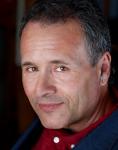(Any errors in this account Ransom Stephens are solely my fault – David Almandsmith)
Ransom Stephens are solely my fault – David Almandsmith)
SkepTalk by Ransom Stephens PhD on 14 January 2018
This SkepTalk combined science, mirth, and intellectual acumen; a genuine treat. Dr. Stephens brought the audience up to date with fruits of neuroscience research and melded them with an evolutionary perspective.
Dr. Stephens began by pointing out that neuroscience in some sense is self-referential – a case of the brain trying to understand itself.
He then warned against over-simplified ideas such as strict roles for the left brain versus roles for the right brain. There are indeed some differences in roles but…
there is some overlap in duties, especially since the brain evinces considerable plasticity. In the most general case, when you walk into a bar (!) the right brain checks for the unexpected – an acquaintance, a hungry leopard, etc. – without ‘you’ necessarily aware of the search. Any significant results of the search are passed off to the left brain and into your consciousness. Sort of. Neuroscience is still in its infancy.
And how does something bubble up into your consciousness? Dr. Stephens likes the metaphor of the coffee percolator: activity heats up down in our unconscious until a ‘boiling point’ when activity percolates up into our conscious. Not a perfect metaphor but somewhat useful at this date.
The normal functioning of the human brain leads to “idea prejudice.” Here is how that works:
- our brain obsessively searches for patterns it might recognize; faces, predators, events
- we frequently perceive patterns when the perception is incorrect; i.e. pareidolia or the misinterpretation of random sequences (person appears in your dream and they have a car accident the next day); we categorize fast and think/analyse slowly
- our brain suppresses things it fails to categorize whether philosophical, cultural, or even visual (I showed a picture of a blimp to a co-worker and she said she had never seen one. I explained
- when the brain encounters previously ‘accepted’ patterns, those patterns are reinforced; this phenomenon, called confirmation bias, applies to visual patterns (face on the moon) as well as to other patterns such cause and effect (my cold went away after drinking rosehip tea) accepted modes of behavior, and value judgments (the mayor is a crook); information suggesting the mayor is decent is suppressed while criticisms of the mayor reinforces the bias
what blimps were and a month later she ‘saw’ one in the sky for the first time.)
Dr. Stephens shared the discovery that infants have two or three times as many neuronal connections as older children. It may be that infants experience mental chaos and synesthesia that lessens as ‘inappropriate’ connections are pruned away leaving functionally ‘valuable’ neural systems.
The question as to which is more important, Nature or Nurture, is so simplistic as to be wrong. Both collaborate to shape the brain. Everything the brain processes originated from the senses.
All ‘normal’ human brains allow the person to develop exceptional talent. A person who devotes intense practice for two hours a day to some complex skill will, in time, be viewed as exceptionally talented, be it in music, mathematics, juggling, video games, etc.
Dr. Stephens offered theories of “consciousness” and “sentience.” He proffered a system where there are levels of sentience. Most of the history of live on our planet consisted of single-celled organisms which amazingly appear to have situational awareness and the ability to respond appropriately to changes around them. Multicellular creatures such as nematodes, anemones, snails, and even plants have somewhat more ability to respond appropriately. Animals with larger brains such as some non-human mammals and dinosaurs (birds) show the additional abilities of abstraction and strategizing. These abilities are rather modest compared to the levels capable of the human brain. It may be that a brain with a hundred billion neurons each with ten thousand axonal connections to other neurons reaches a level where a threshhold effect reaches a critical level that confers a higher level of self-awareness. ¿Or is it still a continuum? The jury is out.
He left us with homework: he suggested we Google Christof Koch. I did that and learned that he is “an American neuroscientist best known for his work on the neural bases of consciousness.” Furthermore he “introduced the concept that consciousness is a fundamental property of networked entities.” Cool.
Books by Dr. Ransom Stephens:
* The God Patent, 2009, a novel
* Your Pursuit of Greatness, 2011
* The Sensory Deception, 2013, a novel
* The Left Brain Speaks, the Right Brain Laughs, 2016
